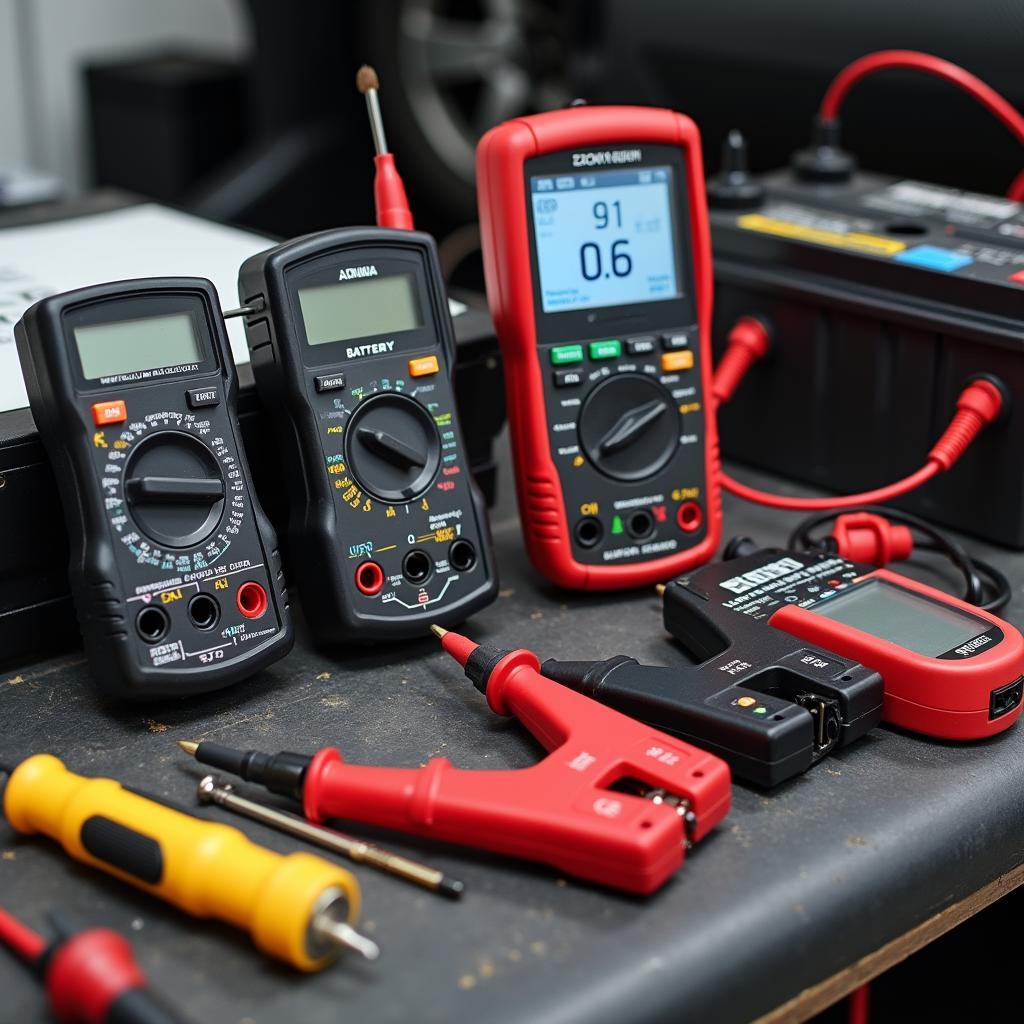A car battery diagnostic tool is an essential piece of equipment for any mechanic or car enthusiast. It allows you to quickly and easily diagnose battery health, identify potential problems, and avoid costly repairs. But with so many different types of car battery diagnostic tools on the market, it can be tough to know which one is right for you. This guide will teach you everything you need to know about car battery diagnostic tools, from the basics to advanced features.
 Types of Car Battery Diagnostic Tools
Types of Car Battery Diagnostic Tools
Why Use a Car Battery Diagnostic Tool?
You might be thinking, “Do I really need a dedicated car battery diagnostic tool?” The answer, in short, is a resounding yes. Here’s why:
- Accuracy: Unlike rudimentary methods, these tools offer precise voltage, current, and resistance readings, painting a clear picture of your battery’s health.
- Early Problem Detection: A car battery diagnostic tool can detect minor issues before they escalate into major (and expensive) problems.
- DIY Savings: Regular battery checks with a diagnostic tool can save you money in the long run by preventing unexpected breakdowns and extending the life of your battery.
Types of Car Battery Diagnostic Tools
There are many different types of car battery diagnostic tools available, each with its own set of features and benefits. Here are a few of the most common:
1. Multimeters
Multimeters are the most basic type of car battery diagnostic tool. They can be used to measure voltage, current, and resistance. Multimeters are relatively inexpensive and easy to use, making them a good option for basic battery testing.
2. Battery Load Testers
A battery load tester applies a load to the battery to simulate the demands of starting the engine. This type of test can help determine if the battery has enough power to crank the engine.
3. Battery Analyzers
Battery analyzers are more advanced than multimeters and load testers. They can provide more detailed information about the battery’s health, such as its state of charge, cold cranking amps (CCA), and reserve capacity.
4. OBD-II Scan Tools with Battery Testing
Many modern OBD-II scan tools come equipped with dedicated battery testing capabilities. These tools connect to your car’s computer system to retrieve data directly from the battery sensor (if equipped). They offer insights into battery performance beyond basic voltage readings.
Choosing the Right Car Battery Diagnostic Tool
When choosing a car battery diagnostic tool, it’s important to consider your needs and budget. If you’re a casual car owner who only needs to do basic battery testing, a multimeter or load tester may be sufficient. However, if you’re a mechanic or a serious DIYer, a more advanced battery analyzer or OBD-II scan tool with battery testing capabilities is a worthwhile investment.
How to Use a Car Battery Diagnostic Tool
Using a car battery diagnostic tool is generally straightforward. However, it’s essential to follow the manufacturer’s instructions carefully.
Here are some general steps:
- Safety First: Always wear safety glasses and gloves when working with car batteries.
- Connect the Tool: Connect the positive (red) lead of the tool to the positive terminal of the battery. Then, connect the negative (black) lead to the negative terminal.
- Select the Test: Consult your tool’s manual to select the appropriate test mode – voltage, CCA, or others.
- Interpret the Results: Compare the readings to the battery’s specifications (usually found on the battery label).
diagnostic tool for checking traction battery on electric car can also provide valuable information about the health of your car’s electrical system.
Common Car Battery Problems and How to Diagnose Them
- Low Voltage: This could be due to a number of factors, such as a failing alternator, a parasitic drain, or simply an old battery.
- Slow Cranking: If your engine is slow to crank, it could be a sign of a weak battery or a bad starter motor.
- Battery Warning Light: If your battery warning light is on, it means there’s a problem with your car’s charging system. This could be a failing alternator, a loose belt, or a problem with the wiring.
car diagnostic tool batter configuration can help you identify and resolve these and other issues, ensuring your car starts reliably every time.
Tips for Extending Car Battery Life
- Regular Testing: Test your battery at least twice a year, or more frequently in extreme temperatures.
- Keep it Clean: Keep your battery terminals clean and free of corrosion.
- Limit Deep Discharges: Avoid completely draining your battery.
- Proper Charging: Use a quality battery charger and follow the manufacturer’s instructions.
By following these tips and using a car diagnostic tool bms, you can help to extend the life of your car battery and avoid costly repairs.
Conclusion
A car battery diagnostic tool is an essential piece of equipment for any car owner. By investing in a quality tool and using it regularly, you can keep your battery in top condition and avoid unexpected breakdowns. Remember, a little preventative maintenance goes a long way!
Need help with car diagnostics? Don’t hesitate to contact our team for expert assistance.
